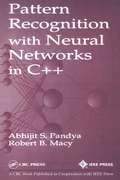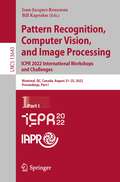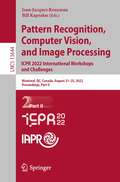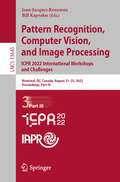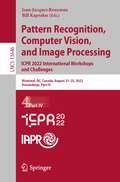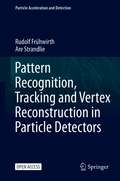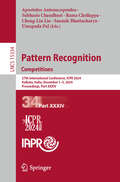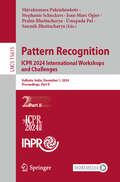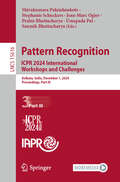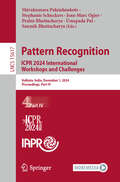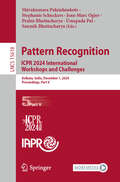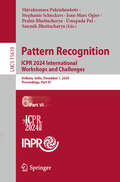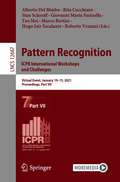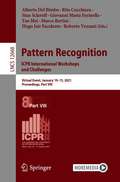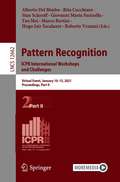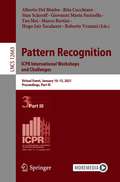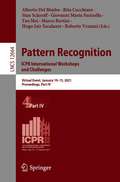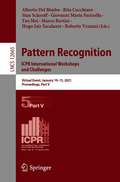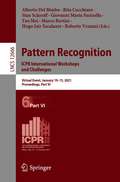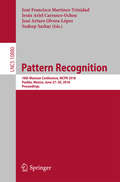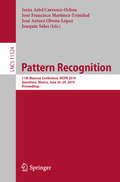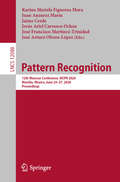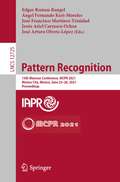- Table View
- List View
Pattern Recognition with Neural Networks in C++
by Abhijit S. Pandya Robert B. MacyThe addition of artificial neural network computing to traditional pattern recognition has given rise to a new, different, and more powerful methodology that is presented in this interesting book. This is a practical guide to the application of artificial neural networks. Geared toward the practitioner, Pattern Recognition with Neural Networks in C++ covers pattern classification and neural network approaches within the same framework. Through the book's presentation of underlying theory and numerous practical examples, readers gain an understanding that will allow them to make judicious design choices rendering neural application predictable and effective. The book provides an intuitive explanation of each method for each network paradigm. This discussion is supported by a rigorous mathematical approach where necessary. C++ has emerged as a rich and descriptive means by which concepts, models, or algorithms can be precisely described. For many of the neural network models discussed, C++ programs are presented for the actual implementation. Pictorial diagrams and in-depth discussions explain each topic. Necessary derivative steps for the mathematical models are included so that readers can incorporate new ideas into their programs as the field advances with new developments. For each approach, the authors clearly state the known theoretical results, the known tendencies of the approach, and their recommendations for getting the best results from the method. The material covered in the book is accessible to working engineers with little or no explicit background in neural networks. However, the material is presented in sufficient depth so that those with prior knowledge will find this book beneficial. Pattern Recognition with Neural Networks in C++ is also suitable for courses in neural networks at an advanced undergraduate or graduate level. This book is valuable for academic as well as practical research.
Pattern Recognition, Computer Vision, and Image Processing. ICPR 2022 International Workshops and Challenges: Montreal, QC, Canada, August 21–25, 2022, Proceedings, Part I (Lecture Notes in Computer Science #13643)
by Jean-Jacques Rousseau Bill KapralosThis 4-volumes set constitutes the proceedings of the ICPR 2022 Workshops of the 26th International Conference on Pattern Recognition Workshops, ICPR 2022, Montreal, QC, Canada, August 2023. The 167 full papers presented in these 4 volumes were carefully reviewed and selected from numerous submissions. ICPR workshops covered domains related to pattern recognition, artificial intelligence, computer vision, image and sound analysis. Workshops’ contributions reflected the most recent applications related to healthcare, biometrics, ethics, multimodality, cultural heritage, imagery, affective computing, etc.
Pattern Recognition, Computer Vision, and Image Processing. ICPR 2022 International Workshops and Challenges: Montreal, QC, Canada, August 21–25, 2022, Proceedings, Part II (Lecture Notes in Computer Science #13644)
by Jean-Jacques Rousseau Bill KapralosThis 4-volumes set constitutes the proceedings of the ICPR 2022 Workshops of the 26th International Conference on Pattern Recognition Workshops, ICPR 2022, Montreal, QC, Canada, August 2023. The 167 full papers presented in these 4 volumes were carefully reviewed and selected from numerous submissions. ICPR workshops covered domains related to pattern recognition, artificial intelligence, computer vision, image and sound analysis. Workshops’ contributions reflected the most recent applications related to healthcare, biometrics, ethics, multimodality, cultural heritage, imagery, affective computing, etc.
Pattern Recognition, Computer Vision, and Image Processing. ICPR 2022 International Workshops and Challenges: Montreal, QC, Canada, August 21–25, 2022, Proceedings, Part III (Lecture Notes in Computer Science #13645)
by Jean-Jacques Rousseau Bill KapralosThis 4-volumes set constitutes the proceedings of the ICPR 2022 Workshops of the 26th International Conference on Pattern Recognition Workshops, ICPR 2022, Montreal, QC, Canada, August 2023. The 167 full papers presented in these 4 volumes were carefully reviewed and selected from numerous submissions. ICPR workshops covered domains related to pattern recognition, artificial intelligence, computer vision, image and sound analysis. Workshops’ contributions reflected the most recent applications related to healthcare, biometrics, ethics, multimodality, cultural heritage, imagery, affective computing, etc.
Pattern Recognition, Computer Vision, and Image Processing. ICPR 2022 International Workshops and Challenges: Montreal, QC, Canada, August 21–25, 2022, Proceedings, Part IV (Lecture Notes in Computer Science #13646)
by Jean-Jacques Rousseau Bill KapralosThis 4-volumes set constitutes the proceedings of the ICPR 2022 Workshops of the 26th International Conference on Pattern Recognition Workshops, ICPR 2022, Montreal, QC, Canada, August 2023. The 167 full papers presented in these 4 volumes were carefully reviewed and selected from numerous submissions. ICPR workshops covered domains related to pattern recognition, artificial intelligence, computer vision, image and sound analysis. Workshops’ contributions reflected the most recent applications related to healthcare, biometrics, ethics, multimodality, cultural heritage, imagery, affective computing, etc.
Pattern Recognition, Tracking and Vertex Reconstruction in Particle Detectors (Particle Acceleration and Detection)
by Rudolf Frühwirth Are StrandlieThis open access book is a comprehensive review of the methods and algorithms that are used in the reconstruction of events recorded by past, running and planned experiments at particle accelerators such as the LHC, SuperKEKB and FAIR. The main topics are pattern recognition for track and vertex finding, solving the equations of motion by analytical or numerical methods, treatment of material effects such as multiple Coulomb scattering and energy loss, and the estimation of track and vertex parameters by statistical algorithms. The material covers both established methods and recent developments in these fields and illustrates them by outlining exemplary solutions developed by selected experiments. The clear presentation enables readers to easily implement the material in a high-level programming language. It also highlights software solutions that are in the public domain whenever possible. It is a valuable resource for PhD students and researchers working on online or offline reconstruction for their experiments.
Pattern Recognition. Competitions: 27th International Conference, ICPR 2024, Kolkata, India, December 1–5, 2024, Proceedings, Part XXXIV (Lecture Notes in Computer Science #15334)
by Rama Chellappa Subhasis Chaudhuri Cheng-Lin Liu Umapada Pal Apostolos Antonacopoulos Saumik BhattacharyaThe multi-volume set of LNCS books with volume numbers 15301-15334 constitutes the refereed proceedings of the 27th International Conference on Pattern Recognition, ICPR 2024, held in Kolkata, India, during December 1–5, 2024. The 963 papers presented in these proceedings were carefully reviewed and selected from a total of 2106 submissions. They deal with topics such as Pattern Recognition; Artificial Intelligence; Machine Learning; Computer Vision; Robot Vision; Machine Vision; Image Processing; Speech Processing; Signal Processing; Video Processing; Biometrics; Human-Computer Interaction (HCI); Document Analysis; Document Recognition; Biomedical Imaging; Bioinformatics.
Pattern Recognition. ICPR 2024 International Workshops and Challenges: Kolkata, India, December 1, 2024, Proceedings, Part I (Lecture Notes in Computer Science #15614)
by Jean-Marc Ogier Shivakumara Palaiahnakote Umapada Pal Prabir Bhattacharya Saumik Bhattacharya Stephanie SchuckersThis 6-volume set LNCS 15614-15619 constitutes the proceedings of the ICPR 2024 International Workshops and Challenges held under the umbrella of the 27th International Conference on Pattern Recognition, ICPR 2024, which took place in Kolkata, India, during December 1–5, 2024. The 183 full papers presented in these 6 volumes were carefully reviewed and selected from numerous submissions. The 21 ICPR 2024 workshops addressed problems in pattern recognition, artificial intelligence, computer vision, and image and sound analysis, and the contributions reflect the most recent applications related to healthcare, biometrics, ethics, multimodality, cultural heritage, imagery, affective computing, and de-escalation.
Pattern Recognition. ICPR 2024 International Workshops and Challenges: Kolkata, India, December 1, 2024, Proceedings, Part II (Lecture Notes in Computer Science #15615)
by Jean-Marc Ogier Shivakumara Palaiahnakote Umapada Pal Prabir Bhattacharya Saumik Bhattacharya Stephanie SchuckersThis 6-volume set LNCS 15614-15619 constitutes the proceedings of the ICPR 2024 International Workshops and Challenges held under the umbrella of the 27th International Conference on Pattern Recognition, ICPR 2024, which took place in Kolkata, India, during December 1–5, 2024. The 183 full papers presented in these 6 volumes were carefully reviewed and selected from numerous submissions. The 21 ICPR 2024 workshops addressed problems in pattern recognition, artificial intelligence, computer vision, and image and sound analysis, and the contributions reflect the most recent applications related to healthcare, biometrics, ethics, multimodality, cultural heritage, imagery, affective computing, and de-escalation.
Pattern Recognition. ICPR 2024 International Workshops and Challenges: Kolkata, India, December 1, 2024, Proceedings, Part III (Lecture Notes in Computer Science #15616)
by Jean-Marc Ogier Shivakumara Palaiahnakote Umapada Pal Prabir Bhattacharya Saumik Bhattacharya Stephanie SchuckersThis 6-volume set LNCS 15614-15619 constitutes the proceedings of the ICPR 2024 International Workshops and Challenges held under the umbrella of the 27th International Conference on Pattern Recognition, ICPR 2024, which took place in Kolkata, India, during December 1–5, 2024. The 183 full papers presented in these 6 volumes were carefully reviewed and selected from numerous submissions. The 21 ICPR 2024 workshops addressed problems in pattern recognition, artificial intelligence, computer vision, and image and sound analysis, and the contributions reflect the most recent applications related to healthcare, biometrics, ethics, multimodality, cultural heritage, imagery, affective computing, and de-escalation.
Pattern Recognition. ICPR 2024 International Workshops and Challenges: Kolkata, India, December 1, 2024, Proceedings, Part IV (Lecture Notes in Computer Science #15617)
by Jean-Marc Ogier Shivakumara Palaiahnakote Umapada Pal Prabir Bhattacharya Saumik Bhattacharya Stephanie SchuckersThis 6-volume set LNCS 15614-15619 constitutes the proceedings of the ICPR 2024 International Workshops and Challenges held under the umbrella of the 27th International Conference on Pattern Recognition, ICPR 2024, which took place in Kolkata, India, during December 1–5, 2024. The 183 full papers presented in these 6 volumes were carefully reviewed and selected from numerous submissions. The 21 ICPR 2024 workshops addressed problems in pattern recognition, artificial intelligence, computer vision, and image and sound analysis, and the contributions reflect the most recent applications related to healthcare, biometrics, ethics, multimodality, cultural heritage, imagery, affective computing, and de-escalation.
Pattern Recognition. ICPR 2024 International Workshops and Challenges: Kolkata, India, December 1, 2024, Proceedings, Part V (Lecture Notes in Computer Science #15618)
by Jean-Marc Ogier Shivakumara Palaiahnakote Umapada Pal Prabir Bhattacharya Saumik Bhattacharya Stephanie SchuckersThis 6-volume set LNCS 15614-15619 constitutes the proceedings of the ICPR 2024 International Workshops and Challenges held under the umbrella of the 27th International Conference on Pattern Recognition, ICPR 2024, which took place in Kolkata, India, during December 1–5, 2024. The 183 full papers presented in these 6 volumes were carefully reviewed and selected from numerous submissions. The 21 ICPR 2024 workshops addressed problems in pattern recognition, artificial intelligence, computer vision, and image and sound analysis, and the contributions reflect the most recent applications related to healthcare, biometrics, ethics, multimodality, cultural heritage, imagery, affective computing, and de-escalation.
Pattern Recognition. ICPR 2024 International Workshops and Challenges: Kolkata, India, December 1, 2024, Proceedings, Part VI (Lecture Notes in Computer Science #15619)
by Jean-Marc Ogier Shivakumara Palaiahnakote Umapada Pal Prabir Bhattacharya Saumik Bhattacharya Stephanie SchuckersThis 6-volume set LNCS 15614-15619 constitutes the proceedings of the ICPR 2024 International Workshops and Challenges held under the umbrella of the 27th International Conference on Pattern Recognition, ICPR 2024, which took place in Kolkata, India, during December 1–5, 2024. The 183 full papers presented in these 6 volumes were carefully reviewed and selected from numerous submissions. The 21 ICPR 2024 workshops addressed problems in pattern recognition, artificial intelligence, computer vision, and image and sound analysis, and the contributions reflect the most recent applications related to healthcare, biometrics, ethics, multimodality, cultural heritage, imagery, affective computing, and de-escalation.
Pattern Recognition. ICPR International Workshops and Challenges: Virtual Event, January 10-15, 2021, Proceedings, Part VII (Lecture Notes in Computer Science #12667)
by Marco Bertini Giovanni Maria Farinella Hugo Jair Escalante Alberto Del Bimbo Stan Sclaroff Rita Cucchiara Tao Mei Roberto VezzaniThis 8-volumes set constitutes the refereed of the 25th International Conference on Pattern Recognition Workshops, ICPR 2020, held virtually in Milan, Italy and rescheduled to January 10 - 11, 2021 due to Covid-19 pandemic. The 416 full papers presented in these 8 volumes were carefully reviewed and selected from about 700 submissions. The 46 workshops cover a wide range of areas including machine learning, pattern analysis, healthcare, human behavior, environment, surveillance, forensics and biometrics, robotics and egovision, cultural heritage and document analysis, retrieval, and women at ICPR2020.
Pattern Recognition. ICPR International Workshops and Challenges: Virtual Event, January 10-15, 2021, Proceedings, Part VIII (Lecture Notes in Computer Science #12668)
by Marco Bertini Giovanni Maria Farinella Hugo Jair Escalante Alberto Del Bimbo Stan Sclaroff Rita Cucchiara Tao Mei Roberto VezzaniThis 8-volumes set constitutes the refereed of the 25th International Conference on Pattern Recognition Workshops, ICPR 2020, held virtually in Milan, Italy and rescheduled to January 10 - 11, 2021 due to Covid-19 pandemic. The 416 full papers presented in these 8 volumes were carefully reviewed and selected from about 700 submissions. The 46 workshops cover a wide range of areas including machine learning, pattern analysis, healthcare, human behavior, environment, surveillance, forensics and biometrics, robotics and egovision, cultural heritage and document analysis, retrieval, and women at ICPR2020.
Pattern Recognition. ICPR International Workshops and Challenges: Virtual Event, January 10–15, 2021, Proceedings, Part I (Lecture Notes in Computer Science #12661)
by Marco Bertini Giovanni Maria Farinella Hugo Jair Escalante Alberto Del Bimbo Stan Sclaroff Rita Cucchiara Tao Mei Roberto VezzaniThis 8-volumes set constitutes the refereed of the 25th International Conference on Pattern Recognition Workshops, ICPR 2020, held virtually in Milan, Italy and rescheduled to January 10 - 11, 2021 due to Covid-19 pandemic. The 416 full papers presented in these 8 volumes were carefully reviewed and selected from about 700 submissions. The 46 workshops cover a wide range of areas including machine learning, pattern analysis, healthcare, human behavior, environment, surveillance, forensics and biometrics, robotics and egovision, cultural heritage and document analysis, retrieval, and women at ICPR2020.
Pattern Recognition. ICPR International Workshops and Challenges: Virtual Event, January 10–15, 2021, Proceedings, Part II (Lecture Notes in Computer Science #12662)
by Marco Bertini Giovanni Maria Farinella Hugo Jair Escalante Alberto Del Bimbo Stan Sclaroff Rita Cucchiara Tao Mei Roberto VezzaniThis 8-volumes set constitutes the refereed of the 25th International Conference on Pattern Recognition Workshops, ICPR 2020, held virtually in Milan, Italy and rescheduled to January 10 - 11, 2021 due to Covid-19 pandemic. The 416 full papers presented in these 8 volumes were carefully reviewed and selected from about 700 submissions. The 46 workshops cover a wide range of areas including machine learning, pattern analysis, healthcare, human behavior, environment, surveillance, forensics and biometrics, robotics and egovision, cultural heritage and document analysis, retrieval, and women at ICPR2020.
Pattern Recognition. ICPR International Workshops and Challenges: Virtual Event, January 10–15, 2021, Proceedings, Part III (Lecture Notes in Computer Science #12663)
by Marco Bertini Giovanni Maria Farinella Hugo Jair Escalante Alberto Del Bimbo Stan Sclaroff Rita Cucchiara Tao Mei Roberto VezzaniThis 8-volumes set constitutes the refereed of the 25th International Conference on Pattern Recognition Workshops, ICPR 2020, held virtually in Milan, Italy and rescheduled to January 10 - 11, 2021 due to Covid-19 pandemic. The 416 full papers presented in these 8 volumes were carefully reviewed and selected from about 700 submissions. The 46 workshops cover a wide range of areas including machine learning, pattern analysis, healthcare, human behavior, environment, surveillance, forensics and biometrics, robotics and egovision, cultural heritage and document analysis, retrieval, and women at ICPR2020.
Pattern Recognition. ICPR International Workshops and Challenges: Virtual Event, January 10–15, 2021, Proceedings, Part IV (Lecture Notes in Computer Science #12664)
by Marco Bertini Giovanni Maria Farinella Hugo Jair Escalante Alberto Del Bimbo Stan Sclaroff Rita Cucchiara Tao Mei Roberto VezzaniThis 8-volumes set constitutes the refereed of the 25th International Conference on Pattern Recognition Workshops, ICPR 2020, held virtually in Milan, Italy and rescheduled to January 10 - 11, 2021 due to Covid-19 pandemic. The 416 full papers presented in these 8 volumes were carefully reviewed and selected from about 700 submissions. The 46 workshops cover a wide range of areas including machine learning, pattern analysis, healthcare, human behavior, environment, surveillance, forensics and biometrics, robotics and egovision, cultural heritage and document analysis, retrieval, and women at ICPR2020.
Pattern Recognition. ICPR International Workshops and Challenges: Virtual Event, January 10–15, 2021, Proceedings, Part V (Lecture Notes in Computer Science #12665)
by Marco Bertini Giovanni Maria Farinella Hugo Jair Escalante Alberto Del Bimbo Stan Sclaroff Rita Cucchiara Tao Mei Roberto VezzaniThis 8-volumes set constitutes the refereed of the 25th International Conference on Pattern Recognition Workshops, ICPR 2020, held virtually in Milan, Italy and rescheduled to January 10 - 11, 2021 due to Covid-19 pandemic. The 416 full papers presented in these 8 volumes were carefully reviewed and selected from about 700 submissions. The 46 workshops cover a wide range of areas including machine learning, pattern analysis, healthcare, human behavior, environment, surveillance, forensics and biometrics, robotics and egovision, cultural heritage and document analysis, retrieval, and women at ICPR2020.
Pattern Recognition. ICPR International Workshops and Challenges: Virtual Event, January 10–15, 2021, Proceedings, Part VI (Lecture Notes in Computer Science #12666)
by Marco Bertini Giovanni Maria Farinella Hugo Jair Escalante Alberto Del Bimbo Stan Sclaroff Rita Cucchiara Tao Mei Roberto VezzaniThis 8-volumes set constitutes the refereed of the 25th International Conference on Pattern Recognition Workshops, ICPR 2020, held virtually in Milan, Italy and rescheduled to January 10 - 11, 2021 due to Covid-19 pandemic. The 416 full papers presented in these 8 volumes were carefully reviewed and selected from about 700 submissions. The 46 workshops cover a wide range of areas including machine learning, pattern analysis, healthcare, human behavior, environment, surveillance, forensics and biometrics, robotics and egovision, cultural heritage and document analysis, retrieval, and women at ICPR2020.
Pattern Recognition: 10th Mexican Conference, MCPR 2018, Puebla, Mexico, June 27-30, 2018, Proceedings (Lecture Notes in Computer Science #10880)
by Jesús Ariel Carrasco-Ochoa José Francisco Martínez-Trinidad José Arturo Olvera-López Sudeep SarkarThis book constitutes the proceedings of the 10th Mexican Conference on Pattern Recognition, MCPR 2018, held in Puebla, Mexico, in June 2018. The 28 papers presented in this volume were carefully reviewed and selected from 44 submissions. They were organized in topical sections named: pattern recognition principles; deep learning, neural networks and associative memories; data mining; and computer vision.
Pattern Recognition: 11th Mexican Conference, MCPR 2019, Querétaro, Mexico, June 26–29, 2019, Proceedings (Lecture Notes in Computer Science #11524)
by Jesús Ariel Carrasco-Ochoa José Francisco Martínez-Trinidad José Arturo Olvera-López Joaquín SalasThis book constitutes the proceedings of the 11th Mexican Conference on Pattern Recognition, MCPR 2019, held in Querétaro, Mexico, in June 2019. The 40 papers presented in this volume were carefully reviewed and selected from 86 submissions. They were organized in topical sections named: artificial intelligence techniques and recognition; computer vision; industrial and medical applications of pattern recognition; image processing and analysis; pattern recognition techniques; signal processing and analysis; natural language, and processing and recognition.
Pattern Recognition: 12th Mexican Conference, MCPR 2020, Morelia, Mexico, June 24–27, 2020, Proceedings (Lecture Notes in Computer Science #12088)
by Jesús Ariel Carrasco-Ochoa José Francisco Martínez-Trinidad José Arturo Olvera-López Karina Mariela Figueroa Mora Juan Anzurez Marín Jaime CerdaThis book constitutes the proceedings of the 12th Mexican Conference on Pattern Recognition, MCPR 2020, which was due to be held in Morelia, Mexico, in June 2020. The conference was held virtually due to the COVID-19 pandemic.The 31 papers presented in this volume were carefully reviewed and selected from 67 submissions. They were organized in the following topical sections: pattern recognition techniques; image processing and analysis; computer vision; industrial and medical applications of pattern recognition; natural language processing and recognition; artificial intelligence techniques and recognition.
Pattern Recognition: 13th Mexican Conference, MCPR 2021, Mexico City, Mexico, June 23–26, 2021, Proceedings (Lecture Notes in Computer Science #12725)
by Jesús Ariel Carrasco-Ochoa José Francisco Martínez-Trinidad José Arturo Olvera-López Edgar Roman-Rangel Ángel Fernando Kuri-MoralesThis book constitutes the proceedings of the 13th Mexican Conference on Pattern Recognition, MCPR 2021, which was planned to be held in Mexico City, Mexico, in June 2021. The conference was instead held virtually. The 35 papers presented in this volume were carefully reviewed and selected from 75 submissions. They are organized in the following topical sections: artificial intelligence techniques and recognition; pattern recognition techniques; neural networks and deep learning; computer vision; image processing and analysis; and medical applications of pattern recognition.
